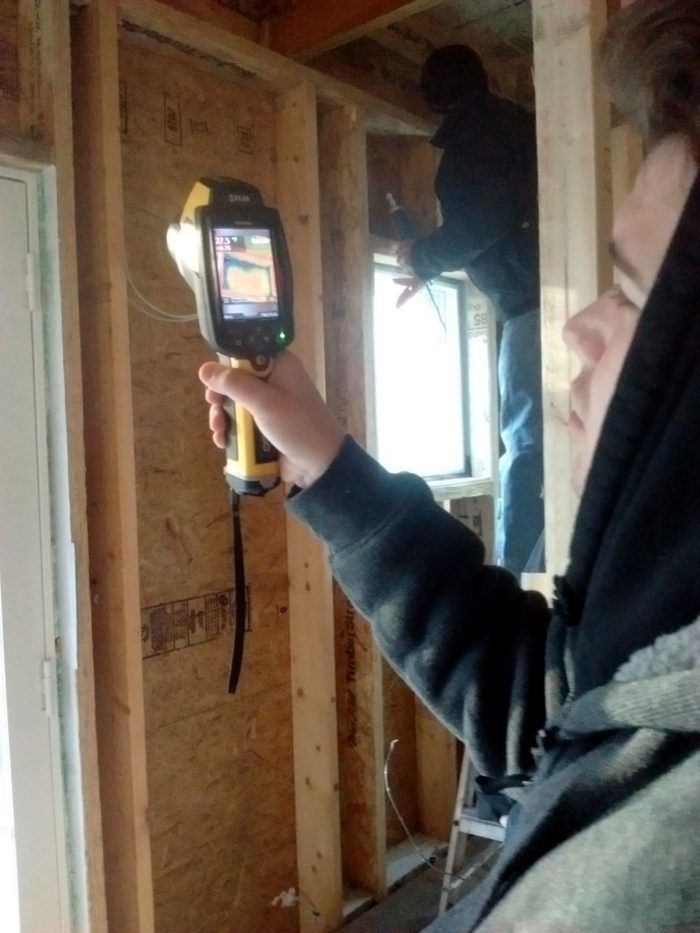
As we framed the house, we air-sealed as much as we could without the assistance of a close envelope that could be pressure-tested with a blower door. We sealed the mudsill joints between the foundation and the Zip Wall sheathing using ProtectoWrap TripleGuard sill seal, the sheathing joints with Zip System tapes, and the top of the wall sheathing to the top plates and blocking with TiteBond acoustical sealant.
We installed Certainteed Membrain as the air barrier on the ceiling of the second floor and sealed it to the exterior top plates with TiteBond WeatherMaster Ultimate MP sealant.
Now we’re at the stage where we need a blower door to exhaust air out of the house, creating a pressure differential between the inside and the outside.
This differential will cause air to leak into the house through all the holes we missed during our initial air sealing process, so that we can locate them and seal them up. And since the house is just framed, with the utilities roughed in, now is the best time to check for leaks. Once the interior insulation and drywall are installed, it will be harder to access air leaks buried inside wall cavities or the top floor ceiling.

Cameron, Matt, Brandon, Derek, Ryan, Damian and Addison worked with me and Mr. Haynes on some or all of three mornings for about 90 minutes each day.
On the first day, the first pass on air-sealing focused on the top floor. sealing up leaks in the Membrain and along the top plate of the exterior wall. We hit the big leaks. Matt used a Flir IR camera to hunt down air leaks that showed up as blue streaks along and between different building materials. It was a particularly cold day, so the IR contrast was good. As Matt located suspect air leak areas, the others sealed them up using tape and sealants.

The second day, they looked for more leaks, with Cameron handling the IR camera and others feeling with their hands for smaller and smaller leaks. Derek and Matt took on the task of sealing the basement slab to the foundation wall. Sealing this gap is important not only to stop air from leaking in but also to block radon gas and soil moisture from entering the house.

Each day the students checked the blower door CFM@50pa when they began and again when they wrapped up as a tally of their progress. And each day the numbers fell. 390 to 340 to 270 and finally 195.
In order to get an accurate CFM reading without the manometer blinking ‘LO,’ they had to crank up the fan speed and pressure differential up to 100pa, which induced the air leaks to whistle, making them easier to locate.
The students calculated the volume inside the air control layer of the house and from that calculated the Air Changes per Hour (ACH) at 0.47 — and there are still more spots to air seal.
Air-sealing is one of the few parts of home building where we can use measuring equipment to assess and quantify our work.




Fine Homebuilding Recommended Products
Fine Homebuilding receives a commission for items purchased through links on this site, including Amazon Associates and other affiliate advertising programs.

100-ft. Tape Measure

Smart String Line

Original Speed Square

























































View Comments
Sealing off air leak places is very important as it directly affects the HVAC units. To maintain the proper airflow in our home it is necessary to contact the professionals like http://bloomfieldcooling.com/air-conditioning-ac-repair-service-essex-county-nj/ to come and check for any place from where the air can leak.
Call me an idiot but I don't understand this obsession with air leakage, just to turn around and install an air exchange unit. I've seen friends with these units wasting large amounts of energy because they don't have the setting right-bringing in far to much make-up air.
I also know people who insist on sleeping with a bedroom window open in sub-freezing temperatures.--seal the house up just to open a window all night!!
A normal house doesn't have a large pressure differenential with the outside, unlike these contrived blower tests. If the furnace uses external air for combustion, the only air being drawn in is by the gas hot water heater. Yes, cooking vent fans would draw in a little more air. Exhausting humid air from the bathroom? Are you kidding, where I live we need all the humidity we can get in the winter and in the summer the central A/C unit easily takes care of that little additional humidity if one forgets to turn on the fan.
Yes, I understand air infiltration from a blowing wind.
I believe in good windows/doors with proper foam sealing and other good building practices, but to go to extreme measures just to turn around and put in an expensive air handler with only an uncalibrated knob, and without any scientific basis for the number of air changes needed seems folly.